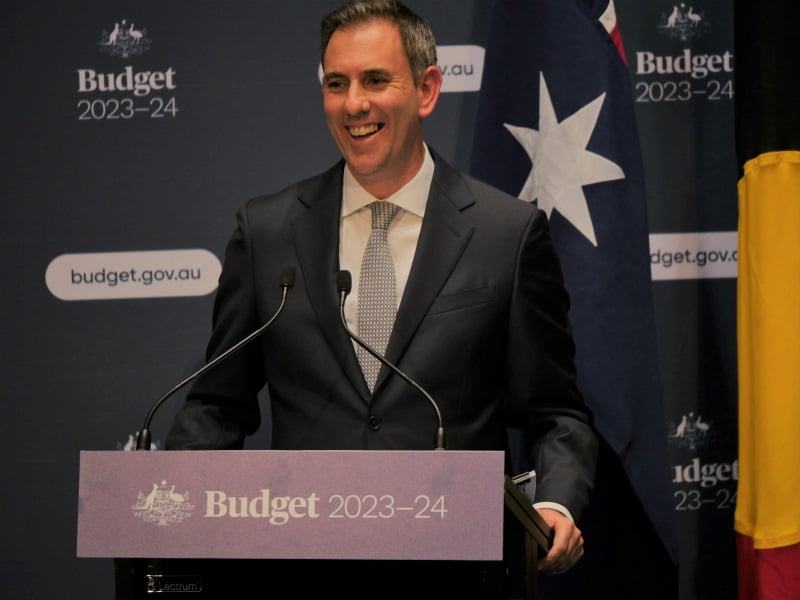Measures to ease cost of living pressures and new investment in Medicare and the care economy will grab the first cut of headlines from Jim Chalmer’s second federal budget, but the Treasurer clearly has one eye on the future, outlining a series of hefty industrial development commitments.
Australia’s biggest opportunity for growth and prosperity lay in the shift to clean energy, he said, declaring a national goal to make Australia an “renewable energy superpower” and outlining a series of new programs targeting energy transition investments.
The budget included new money for accelerating the development of critical technologies industries – most notably quantum tech and artificial intelligence.
And it included new programs to lock Australia into strategic supply chains, including for the critical minerals that will underpin the future growth industries, from the batteries that will drive the global energy transition to their innumerable uses in electronics.

This was a budget with two central messages. The first was to demonstrate a safe pair of hands in returning a budget to surplus and managing of cost-of-living pressures. And the second was about laying a foundation for future economic growth through investment in emerging technologies and new industries.
“We know the best long-term guarantee of rising living standards, stronger wages and a better quality of life is a growing and productive economy,” Mr Chalmers said, before outlining the most sweeping programs of industrial development of any budget in years.
The centrepiece of Australian industry policy remains the $15 billion National Reconstruction Fund as a growth engine for the economy.
But this budget has also delivered a new flagship to the Industry portfolio with the unveiling of a $392 million Industry Growth Program.
The Industry Growth Program will provide advice and matched grant funding to startups and SME’s from $50,000 to $5 million with the aim of creating a pipeline of quality, investment-ready projects for the National Reconstruction Fund to consider.
The Industry Growth Program replaces the Coalition’s sometimes controversial Entrepreneurs Programme and takes the best parts of the Accelerating Commercialisation grants-based component of that program and adds a substantial mentoring and support component.
The Industry Growth Program is aligned to the National Reconstruction Fund’s seven priority investment areas.
“This program will offer advice and grants to startups and small-to-medium businesses, to help them commercialise their ideas and grow,” according to Industry department budget documents.
“This will enable emerging businesses to become the big employers of the future – backing our innovators with investment and advice so they can make the jump from brilliant idea to business plan to a growing enterprise,” it said.
“Via grants and mentorship, Australia’s new Industry Growth Program will expand the pipeline of investment-ready projects for the $15 billion National Reconstruction Fund to consider in coming years.”
The government said this kind of “end-to-end” approach to shepherding high-potential companies through the industry support system would maximise the return on taxpayer investment.
It would also provide a clear pathway for local entrepreneurs and researchers to commercialise their ideas and innovations in Australia rather than heading offshore.
Details of the operational elements of the Industry Growth Program are scant. A new committee of industry leaders is expected to be set up to review and approve applications for grant funding, but how the rest of the program is administered is not yet clear.
As an industry led program, there are clear overlaps with the Industry Growth Centre program, which draws to close on June 30 next year.
While specific details have yet to emerge, an Industry department spokesperson said that while Industry Growth Centre program would end on June 30 next year, there would be a mechanism through which existing growth centres can be funded through the new $392 million Industry Growth Program.
The budget also fulfilled an election promise by committing $14.8 million over four years from 2023/24 to establish a new Powering Australia Industry Growth Centre as a standalone initiative to develop advanced technology and skills in building batteries in this country.
The government committed $61.4 million over four years from 2023/24 – and $1.2 million ongoing – to establish the National Reconstruction Fund Corporation that will administer the $15 billion NRF.
Interestingly, the budget papers reveal that the NRF will earn an estimated $188.7 million over the forward estimates from the NRF investments in loans, equity investments and guarantees, with those returns to be reinvested to ensure the NRFC’s sustainability.
Also unveiled as part of its “enhanced support for small and medium-sized businesses and startups measures” the budget also provided $39.6 million over four years – and $11 million ongoing – to continue the Single Business Service that supports SME engagement with all levels of government.
More 2023 Budget coverage:
Budget lays out $2bn for government tech overhaul
Budget 2023: $2bn for green hydrogen production credits
Defence commits $151m to AUKUS pillar two
My Health Record gets $429m for technology upgrade
Govt backs Quantum and AI industries with $101m
Full Monty ambition for critical minerals supply chains
STEM programs get a tickle rather than an upgrade
myGov gets Budget certainty, new money flows to Digital ID
APS in-house consultancy locked in with $11m
eSafety resources quadruple as national cyber office funded
Do you know more? Contact James Riley via Email.

